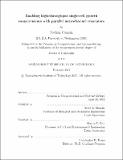Enabling high-throughput single-cell growth measurements with parallel microchannel resonators
Author(s)
Cermak, Nathan
DownloadFull printable version (36.34Mb)
Other Contributors
Massachusetts Institute of Technology. Computational and Systems Biology Program.Nathan Cermak.
Advisor
Scott R. Manalis and Martin F. Polz.
Terms of use
Metadata
Show full item recordAbstract
Single cells constitute a fundamental unit of biological organization, yet most laboratory techniques are unable to characterize single cell behavior and instead measure average properties of many thousands of cells. Among cellular behaviors, one of the most fundamental is growth, in which a cell turns inanimate material into biomass, which is then used to further create more biomass. However, there are few tools available to study the process of single cells growing. In this thesis, I demonstrate a new method for observing and quantifying the growth of single cells in high-throughput. This method is applicable to any cell that can grow in suspension (including bacteria, yeast, and mammalian cells), is extremely precise, and directly measures single-cell biomass accumulation. This method utilizes an array of suspended microchannel resonators (SMRs), which are microcantilevers with an interior fluidic channel through which cells flow. Cells traversing the interior fluidic channel transiently change the mass of the microcantilever, changing its resonant frequency, which we measure. Previously, it has only been possible to operate a single SMR per microfluidic chip. To enable high-throughput growth measurements, we first developed scalable hardware to operate multiple SMRs on a single chip, utilizing frequency-division multiplexing and a digitally-implemented phase-locked loop array. We call this hardware MURC - the MUltiple Resonance Controller. Outside of operating SMRs, we envision that MURC may ultimately be useful for operating many resonator-based sensors (including mass, light, or force sensors). We next developed a microfluidic chip called the serial SMR array, consisting of 10- 12 SMRs interspersed along a single long microfluidic channel. Cells are periodically weighed as they flow through this channel, typically every 30 seconds or every two minutes. The change in cell mass between when a cell enters and exits the channel tells us how fast the cell is growing. Importantly, an entire queue of cells can transit this array nearly simultaneously, yielding growth rate measurements of hundreds of cells per hour. Compared to existing methods, this system is at least an order of magnitude more precise and provides similar or higher throughput.
Description
Thesis: Ph. D., Massachusetts Institute of Technology, Computational and Systems Biology Program, 2017. This electronic version was submitted by the student author. The certified thesis is available in the Institute Archives and Special Collections. Cataloged from student-submitted PDF version of thesis. Includes bibliographical references (pages 119-130).
Date issued
2017Department
Massachusetts Institute of Technology. Computational and Systems Biology ProgramPublisher
Massachusetts Institute of Technology
Keywords
Computational and Systems Biology Program.Nathan Cermak.